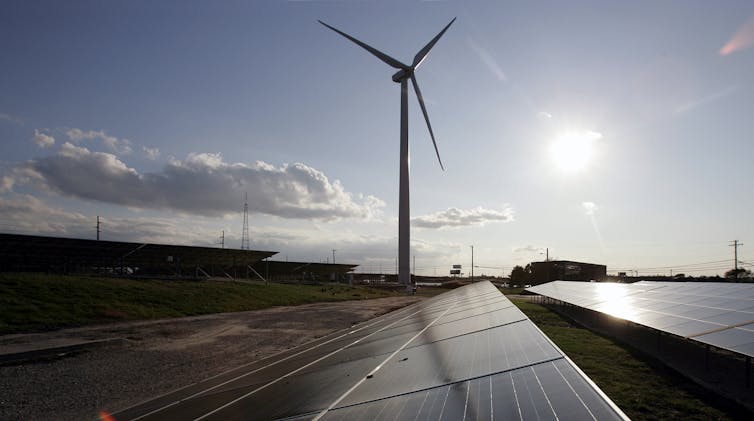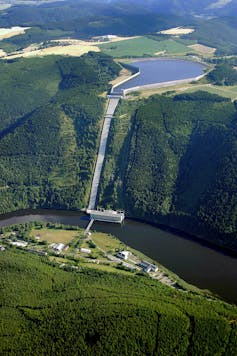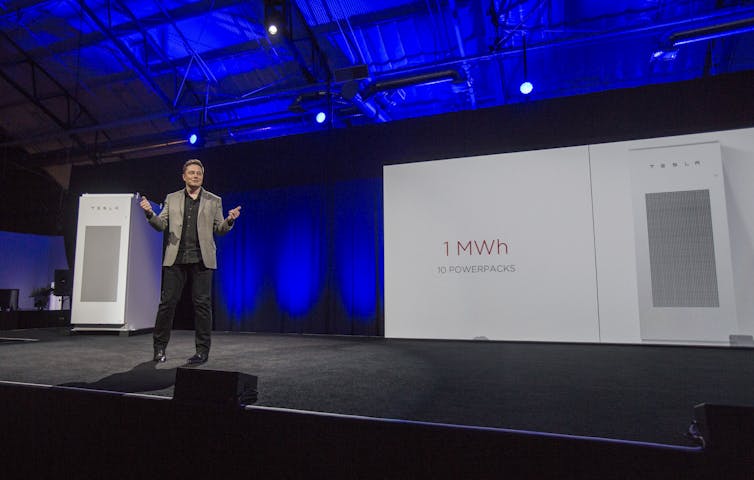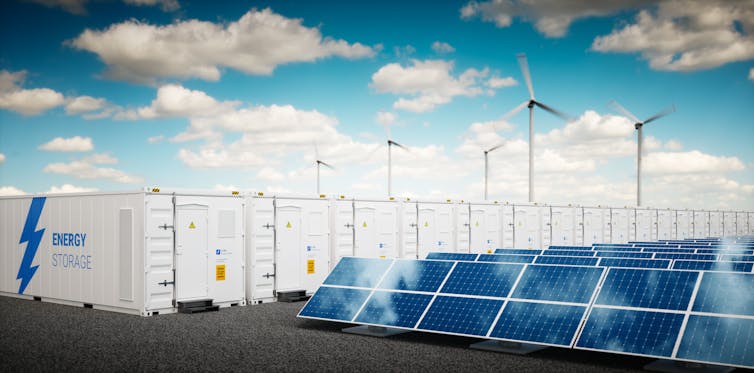
Carbon-free energy: Is the answer blowing in the wind? Perhaps, but the wind doesn’t always blow, nor does the sun always shine. The energy generated by wind and solar power is intermittent, meaning that the generated electricity goes up and down according to the weather.
But the output from the electricity grid must be controllable to match the second-by-second changing demand from consumers. So the intermittency of wind and solar power is an operational challenge for the electricity system.
Energy storage is a widely acknowledged solution to the problem of intermittent renewables. The idea is that storage charges up when the wind is blowing, or the sun is shining, then discharges later when the energy is needed. Storage for the grid can be a chemical battery like those we use in electronic devices, but it can also take the form of pumping water up a hill to a reservoir and generating electricity when letting it flow back down, or storing and discharging compressed air in an underground cavern.

Motivated by a view that storage is a “green” technology, governments are increasingly promoting utility-scale and distributed energy storage. For example, in November 2017, New York Gov. Andrew Cuomo signed a bill mandating targets for storage adoption by 2030. Other states with similar policies are Oregon, Massachusetts, California and Maryland. Companies like Tesla also have been branding storage systems as clean technologies.
But do large storage systems lower emissions in our current grids? In a recent study, we found this isn’t necessarily the case – a reflection of how complex the electricity system can be.
The role of coal
Because storage can enable renewables to meet changing demand, we often assume the technology is inherently green – that is, by adding storage and renewables to the grid, we reduce greenhouse gas emissions. It’s similar to noticing that computers can provide education and productivity benefits, and then assuming that everything a person does on a computer is educational or productive. For both energy storage and computers, it depends on how you use it.
In our analysis, we found that adding storage can, for some grids, increase carbon emissions. While counterintuitive at first glance, this result makes sense when one considers how electricity grids are operated. Broadly speaking, the entire U.S. grid is operated as a set of regional sub-grids that cover the U.S. like a patchwork quilt.

Energy storage has no smokestack emissions like coal or natural gas power plants. But new storage affects the operation of other power plants on the grid, resulting in an increase or a decrease in carbon emissions depending on the type of power plants supplying electricity for that region.
In most cases, storage systems in the U.S. operate to maximize profit. To do this, storage “buys low and sells high.” Electricity is typically cheap at night when demand is low, and more expensive in the daytime, especially when people are getting home from work and turning on a bunch of appliances. So storage system operators tend to buy at night and sell during the day. The net effect of storage on emissions thus depends on what kind of generators are used to meet new demand at night versus the day.
In grids with a lot of coal power – Midwestern, Western and Southern states rely heavily on coal – the coal plants are typically used to meet small changes in demand at night. Natural gas plants tend to work during the day to meet peak demand. In these electricity grids, storage tends to charge up with coal power at night, displacing natural gas power during the day.
Coal power is a dirtier source of electricity than natural gas, with about twice the carbon emissions for every unit of electricity produced. Therefore, in places where new storage means more coal and less natural gas generation, storage will increase total carbon emissions from the grid.
In the Midwest, we found that adding a storage capacity of 3 gigawatts, enough power to supply roughly 500,000 U.S. homes, raises carbon emissions an equivalent of adding 6,700 cars per year to the road. And as more storage is added, the carbon emissions increase.
On the other hand, we found that in New York, a state with very little coal power, adding storage reduces carbon emissions. The Midwest is currently the dirtiest electricity grid in the U.S., and New York is one of the cleanest, so other regions would fall somewhere in between.
Not always easy being green
So, how can grid planners achieve the promise of a happy marriage between storage and renewables, assuming that they have to live in the same house with crusty old Uncle Coal?
One possibility is that, even with storage operating to maximize profit, adding enough wind and solar to the grid could counteract the effect of coal. With enough excess renewable energy, storage in any form – batteries or water reservoirs, for example – would preferentially use solar and wind because they are the cheapest sources when the supply of power exceeds the demand. Storage would still be shifting coal power from night to day, but enabling renewables more would be enough to make up for the extra emissions.

We studied this and found that for the Midwest grid there is a turning point when wind and solar reach about 18 percent of total generating capacity: At that point, adding storage starts to decrease rather than increase emissions. The current adoption level is 10 percent, so it would take some time before storage in the Midwest reduces emissions.
Another option is to change how storage is operated. With a modest price on carbon, for example, the cost of different generators would shift so that storage charges less often from coal plants, reducing emissions even in the coal-heavy Midwest grid.
While a national carbon tax does not look likely in the near future, there are others paths to ensuring green outcomes from storage. For example, states can put in place policies that encourage more use of zero-carbon resources instead of coal.
![]() Regardless, storage will always help us to use more of our low-cost electricity sources. The question is whether that is coal, nuclear or renewables.
Regardless, storage will always help us to use more of our low-cost electricity sources. The question is whether that is coal, nuclear or renewables.
Naga Srujana Goteti, PhD Student in Energy and Sustainabiltiy, Rochester Institute of Technology; Eric Hittinger, Assistant Professor of Public Policy, Rochester Institute of Technology, and Eric Williams, Associate Professor of Sustainability, Rochester Institute of Technology

